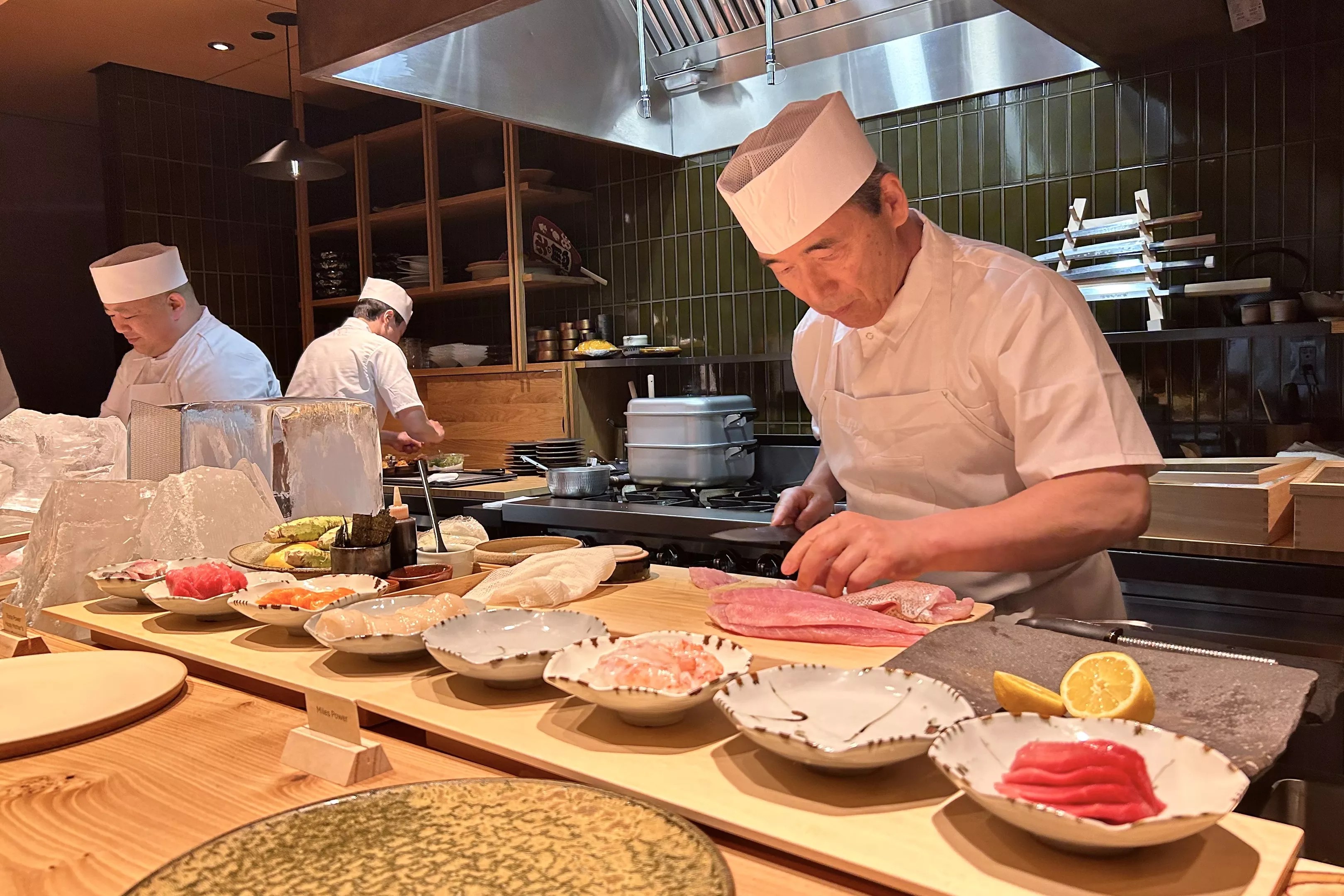
Abigail Bliss

Audio By Carbonatix
Few local restaurants invoke reverence like Kizaki. The new omakase counter is helmed by chef Toshi Kizaki, who co-founded Sushi Den with his brother in 1984. Forty years of success have brought about several additional concepts including Temaki Den, Izakaya Den and Ototo, which neighbor the duo’s award-winning flagship eatery.
Now, this stretch of South Pearl Street, also known as Den Corner, includes Kizaki’s first solo concept. One of this year’s most anticipated restaurant openings, his eponymous chef’s counter resides within Denchu, a larger space where diners begin their experience. Here’s what we experienced at Kizaki one month after its April 11 debut.
The Space
Kizaki’s lack of exterior branding may speak to its exclusivity – other omakase restaurants take a similar understated approach. But it’s also possible that signage is yet to come, as Denchu is still adding some final touches. Paper covers its eye-level windows, giving passersby no indication of what’s inside.
Denver, make your New Year’s Resolution Count!
We’re $15,500 away from our End-of-Year campaign goal, with just a few days left! We’re ready to deliver — but we need the resources to do it right. If Westword matters to you, please contribute today to help us expand our current events coverage when it’s needed most.
Walking through its door, I stepped into a vacant, shadowy hallway. The wood wall to my right was unfinished, leading me to question if I was in the right place. But I continued down the corridor and opened another door at the end of the hall, which led into the bright and spacious restaurant. There, certified sake sommelier Yuki Minakawa greeted me and welcomed me to the bar.
Though so far only hosting omakase diners, Denchu feels finished and, fortunately, not at all like a construction zone. Upper windows flood the space with natural light, adding to the serene environment that successfully invokes a greenhouse ambiance. The sycamore wood bar is contrasted by an accent wall of black Brazilian limestone, which backdrops rows of curated spirits.
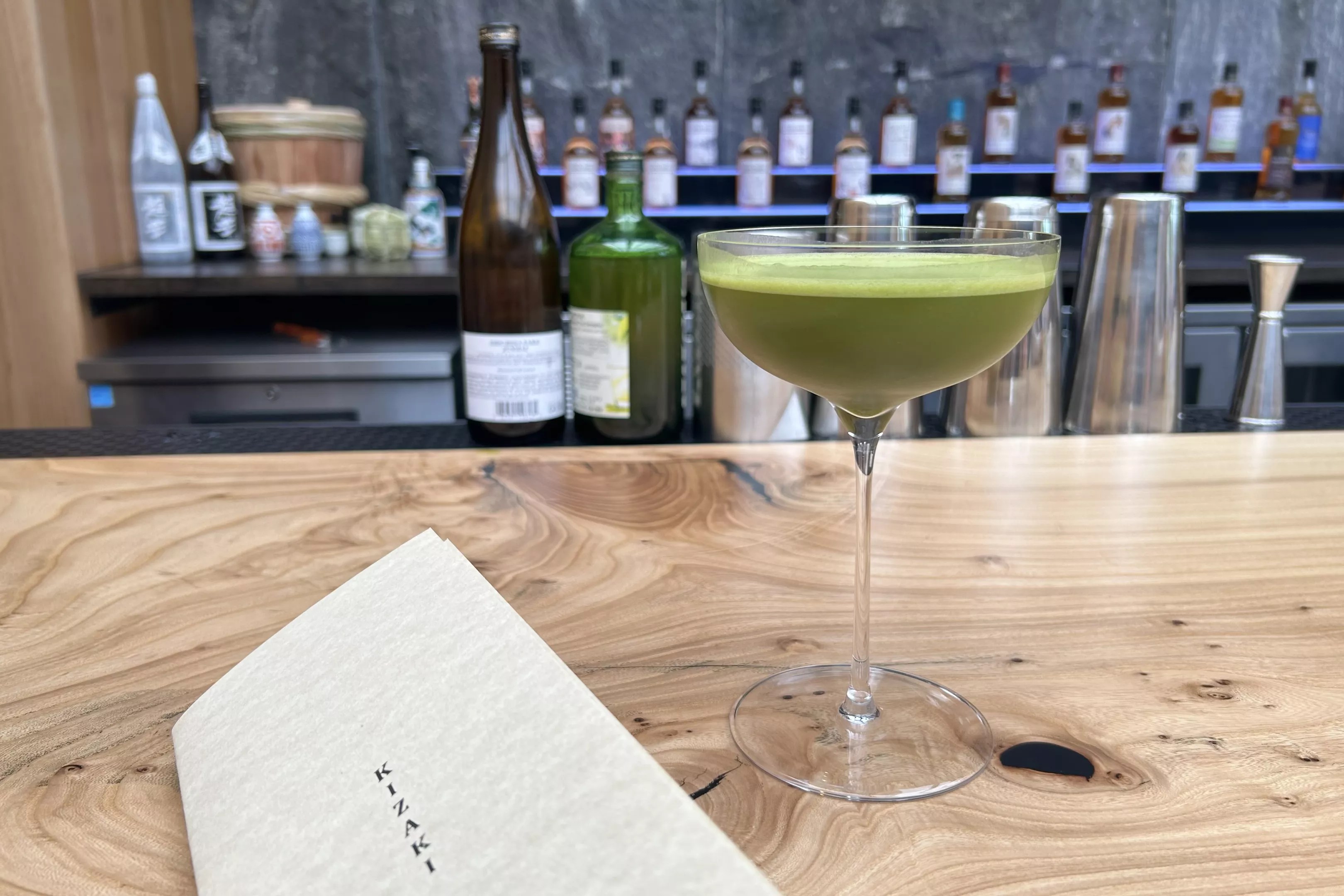
A matcha martini from the bar within Denchu.
Abigail Bliss
Minakawa oversees the beverage program; I opted for her signature, an earthy and velvety matcha martini garnished with gold dust. Savoring it perhaps too slowly, the cocktail came with me into Kizaki – a restaurant within a restaurant, hidden behind yet another door. This intimate, dimly lit space is largely occupied by the chef’s counter, which is made from Siberian elm and seats nine. Behind it, chef Kizaki and his three colleagues moved methodically as they prepared for service.
The Menu
Though Kizaki primarily communicates in his native Japanese, he graciously welcomed the evening’s guests before prep cook Kyle Kim introduced the first course: ichiban dashi, a fish bone broth. “This is meant to be a palate opener,” he explained, noting the inclusion of umeboshi (Japanese pickled plum) and the arare (puffed rice crackers) floating on top.
My first sake pairing arrived next, Nabeshima Junmai Daiginjo. Made from special Aiyama rice grown in Japan’s Saga prefecture, this crisp wine complemented dueling kaiseki dishes. Chef Kizaki recommended starting with the marbled black and white sesame tofu topped with an isolated fava bean and grated egg yolk. This silky, delicate bite was followed by a lightly fried Alaskan cod marinated in a tangy sweet-and-sour sauce.

Marinated cod and marbled sesame tofu were served as the second course.
Abigail Bliss
Then, a sushi course was served, displaying the first of many traditional edomae techniques. “Torishirazu is a cured salmon. Typically, salmon in Hokkaido would be caught in August. However, we’re catching it earlier before the salmon give birth, so they have a lot of fat and oil,” commented Kim. The meat was made even richer with an olive oil marinade. Diced mango added sweetness to the sashimi, while grapefruit, pickled shallots, capers and a dash of lemon juice delivered a pleasant acidity.
Citrus also appeared in the next sushi course, goma kampachi, which featured three thinly cut pieces of Hawaiian yellowtail amberjack marinated in a sesame-soy blend and served with orange slices for each.
Next came one of my favorite dishes of the evening. Serving one hand-roll at a time, chef Kizaki tucked fatty tuna, scallions and a scoop of caviar into ultra-crisp, umami-rich seaweed, which is only offered at one other restaurant in the country.
Another stand-out course followed, served beneath a bowl filled with smoke. Before unveiling the grilled tuna collar, Kizaki lifted a large piece of cut fish and demonstrated the muscle’s movement. This special cut grants just three to five servings per fish, hence why the restaurant reserves it strictly for omakase experiences. It was absolutely decadent and reminiscent of ribeye steak; a squeeze of finger lime gave the dish a bright, zesty pop.
Minakawa poured a fruit-forward, yet dry bottle of Tenbu Junmai Ginjo sake to pair with the next round of sushi, which began with another rarity: jikinme, a golden eye snapper that can only be caught in Chiba prefecture, Japan. Horse mackerel, raw sweet shrimp and kelp-marinated blackthroat seaperch sashimi followed, all brushed with nikiri – a light blend of sake, mirin and soy sauce.
The eleventh course was a lightly breaded tilefish served alongside maitake mushrooms, asparagus, tomato and paprika sauce, plus a garnish of thinly fried carrots. I’ve never tasted such a balance of elegance and comfort. Kim also explained that because sushi is cold, a very fatty fish will create a layer of oil in one’s mouth. “A warm dish will flush that out and basically reset your palate for the next fish to come.”
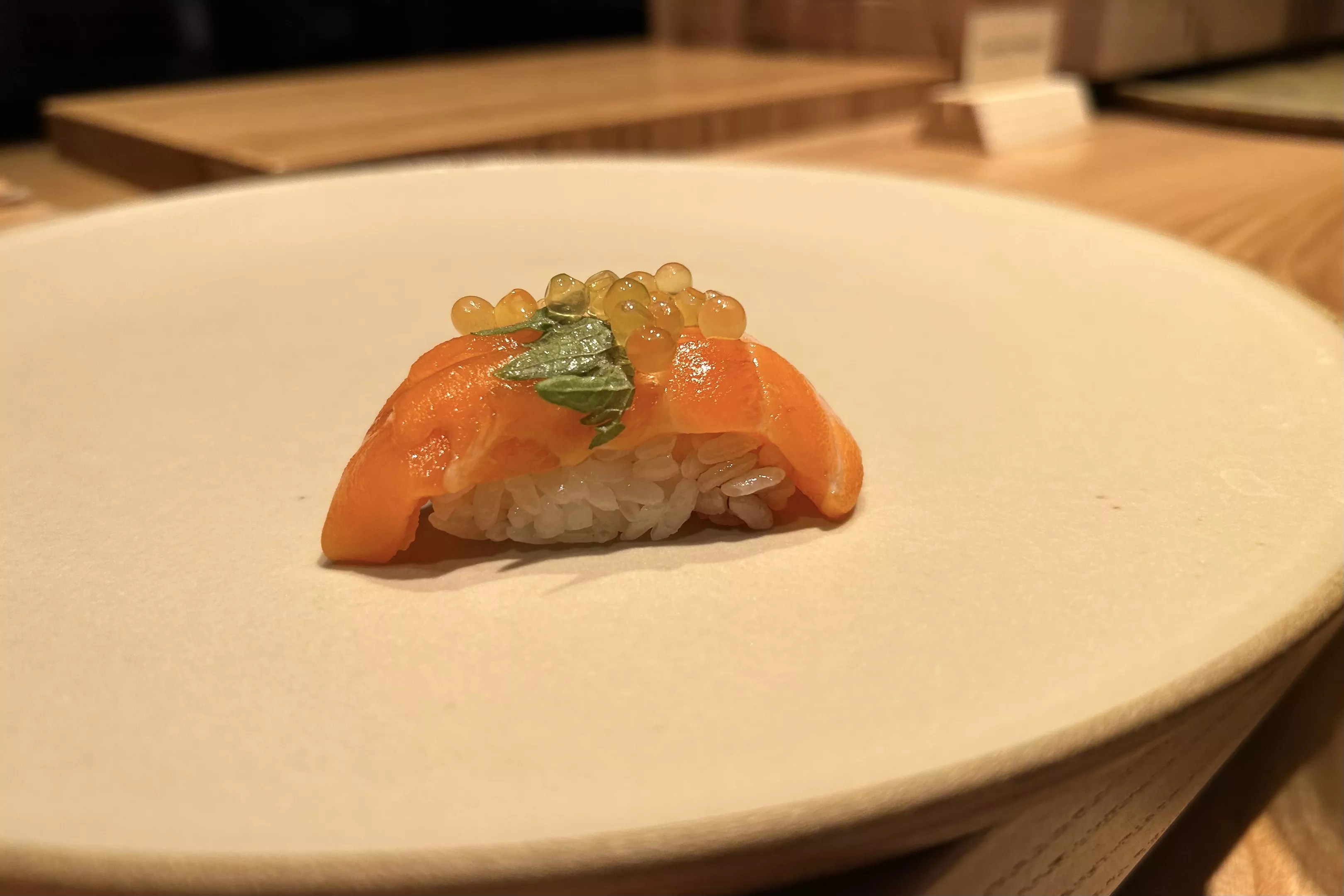
King salmon topped with golden trout roe, served as the thirteenth course.
Abigail Bliss
A flight of seared scallops, New Zealand king salmon crowned with golden trout roe (another one of my favorite dishes) and tobiko-topped seared lobster followed. These bites paired beautifully with a clean, mineral-rich pour of Hitakami Chokarakuchi Junmai, a sake from Miyagi prefecture. Like previously, this round of sushi ended with a palate-cleansing kaiseki dish: a warm bowl of steamed, savory Japanese egg custard featuring snow crab and a splash of yuzu juice.
An aromatic, acidic bottle of Junmai Ginjo Nama from Masami sake brewery was matched with the last round of sushi, which spotlighted rice seasoned with rare red vinegar and various cuts of tuna. “You’ll notice it’s almost like an ombre where it goes from lean to fatty,” commented Kim of the first chutoro dish.
Chef Kizaki’s most unconventional course of the evening followed: a marinated tuna traditionally preserved with soy sauce, but topped with blue cheese. I was expecting a sharp, funky flavor, but the experimental addition married with the fish seamlessly. A fatty, grilled piece of otoro closed out the tuna tour.
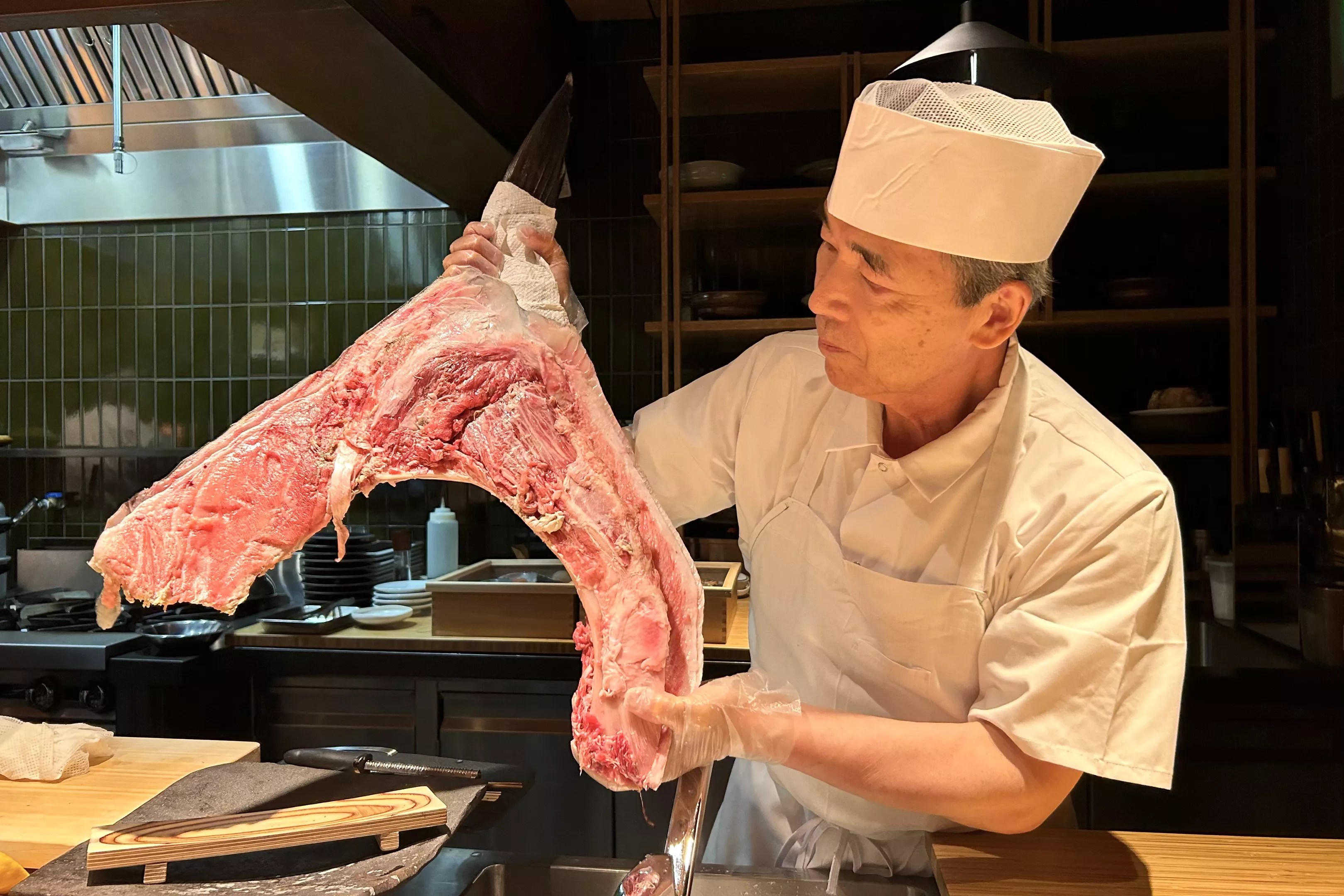
Toshi Kizaki demonstrating a tuna collar’s movement.
Abigail Bliss
The nineteenth course comprised two pieces of a sea eel and cucumber roll dotted with housemade eel sauce. Feeling very satisfied at this point, I was quietly relieved when the final dish of the evening was announced.
“In a traditional Japanese omakase, we always finish with a soup – so we’re doing a miso soup with Manila clams. Chef Toshi wants everyone to know the reason why we do clams is because clams are supposed to be good after drinking. He says if you drink the soup, you can always have another drink,” joked Kim. Following the chef’s guidance, I slurped it down and ended the night with a lychee martini at neighboring sister concept Ototo – but not before dessert, of course.
Choosing from the list of available hot teas, I paired my final bites with a steaming cup of nutty buckwheat tea. Like all the savory dishes that preceded them, the not-too-sweet treats were extraordinary, especially the housemade mochi filled with custard cream, red bean paste and fresh strawberries. The sprinkle of matcha on the outside of the rice paper complemented the second dessert: a pudding that incorporated roasted green tea into three components, including a finishing sauce and a delicate leaf-shaped cookie.
The Wrap-Up
While some signature dishes are standard, the menu frequently rotates. Before departing, chef Kizaki signs the back of each guest’s printed copy. He describes his new omakase counter as his “vision of retirement,” a testament to his dedication, craft and very long, successful career in Denver.
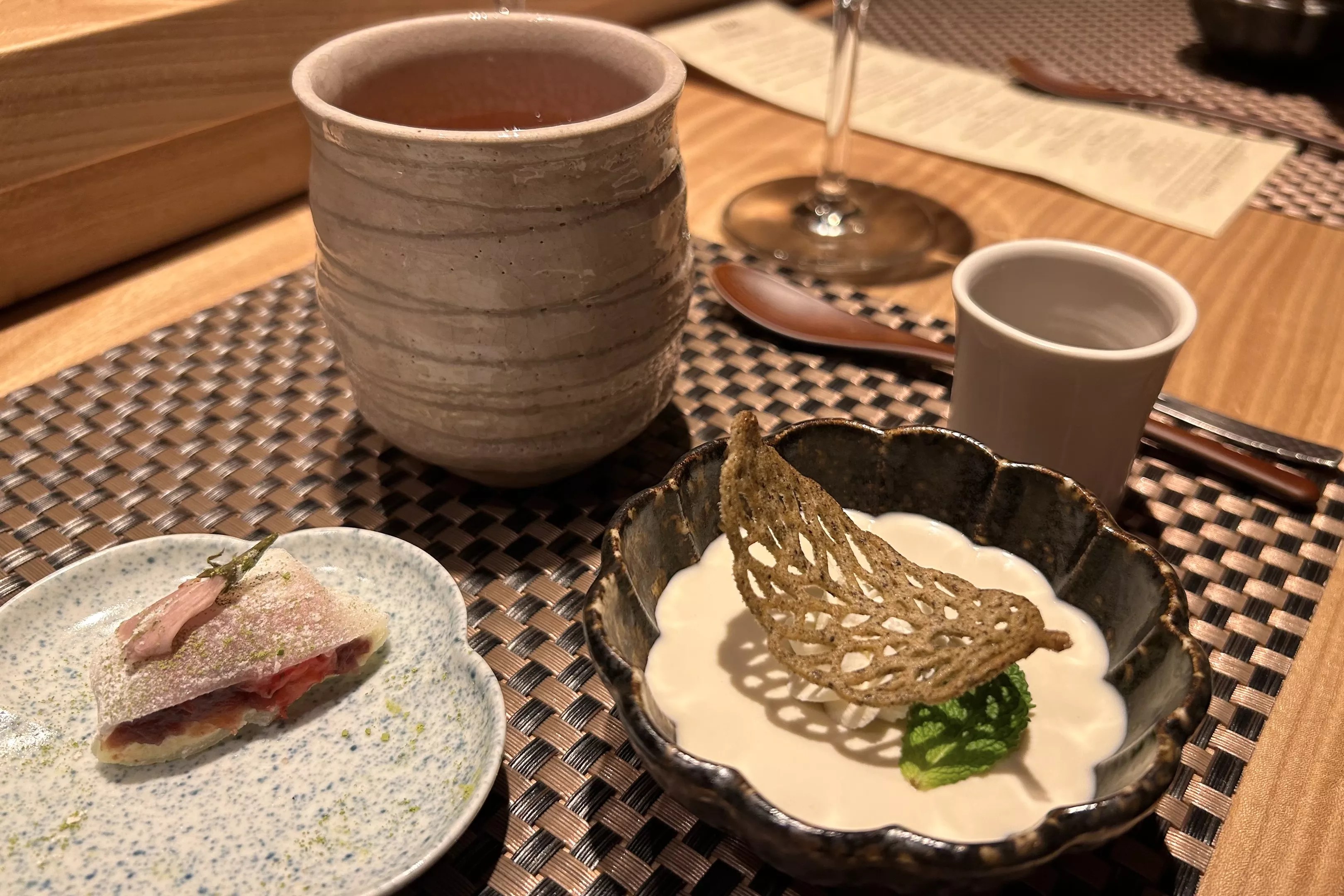
Buckwheat tea paired with a duo of desserts.
Abigail Bliss
To witness one of Denver’s most influential chefs exercise his lifelong passion is the rarest aspect of the restaurant – more than the snapper, red vinegar, unique seaweed and so forth. Though seventy, Kizaki is clearly not done yet, and his latest concept is off to a strong start.
Kizaki is located within Denchu at 1551 South Pearl Street. The omakase meal is offered at 5 and 8 p.m. Thursday through Sunday at $225 per person; reservations are available on OpenTable.